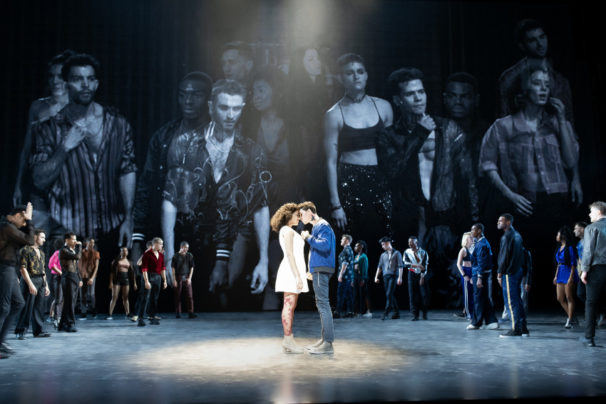
Broadway’s current revival of West Side Story—the groundbreaking 1957 musical by Jerome Robbins, Arthur Laurents, Leonard Bernstein, and Stephen Sondheim whose dramatic power has long been associated with kinetic energy and eloquently focused movement opens simply. The Jets saunter to the front of the vast, bare Broadway Theater stage and stare out defiantly.
The first real movement occurs far behind them, all the way upstage, where a very large video screen projects images of the gang members’ faces from stage left to stage right. That enormous screen, essentially substituting for scenery, provides a pretty-much nonstop series of video images throughout the 105-minute, intermission-less show. It feels so sudden—and so disconnected from the quiet urgency of the dynamic Prologue—that I almost laughed. It was like watching a parade of head shots: oversized views of diverse, very-hip hairstyles and interesting tattoos.
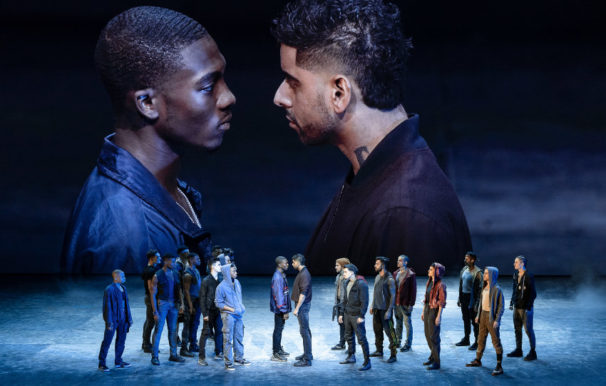
The Sharks then assemble downstage on the other side, volatile and anticipatory, and we are introduced to them in close-up as their large images travel in the other direction, stage right to left. It’s a relief when the tension-filled music accelerates into a percussive section and the men explode into movement. There is plenty of energy but it’s difficult to focus, to identify two distinctive groups and how they interact—especially when video images return and compete for the eye’s attention.

Director Ivo van Hove’s fascination with – and reliance on – video has become his theatrical trademark and it seems his producers, chiefly Scott Rudin, gave him free rein to overuse it here without questioning exactly its appropriateness. The video competes with, and often dwarfs, the stage action. When it consists of existing footage – for example, dark, damp urban street scenes, or members of the gangs seething intensely and expressing pent-up anger — it can veer into cliché. A most absurd example is the romantic lead, Tony, in footage, his face contorted in agony, his teeshirt blood-stained, running desperately in slow motion down an empty street, to Anita and Maria’s counterpoint duet, “A Boy Like That”/”I Have a Love.”
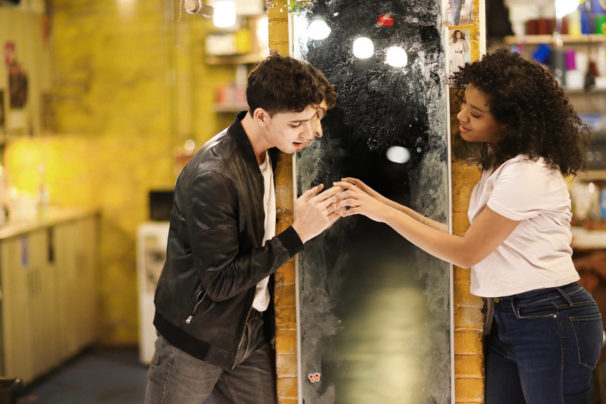
The production’s accumulation of absurdities and incongruities unfortunately distracts from some powerful and eloquent performances. The leads are all well cast. Isaac Powell as Tony is a tremulously sensitive, slightly awkward romantic who brings heartfelt spontaneity and a gorgeous vocal flexibility to his performance of “Maria.” Shereen Pimentel is feisty, almost tough, as Maria – a young woman who knows her own mind. If anything it’s hard to accept she’s a new immigrant to New York, still getting acclimated. But her fervent, heedless discovery of true love is palpably believable, and she sings gorgeously throughout.
Lanky Dharon E. Jones is vastly different from previous compact, muscular men who played Riff, and he radiates anger, resentment and frustration most convincingly. Amar Ramasar, explosive in his many dance scenes, is impossible not to watch. His connection with Anita (the vivid Yesenia Ayala) comes through effortlessly, and they provide some of the more sizzling dance energy both in the “Dance at the Gym” and “America.”
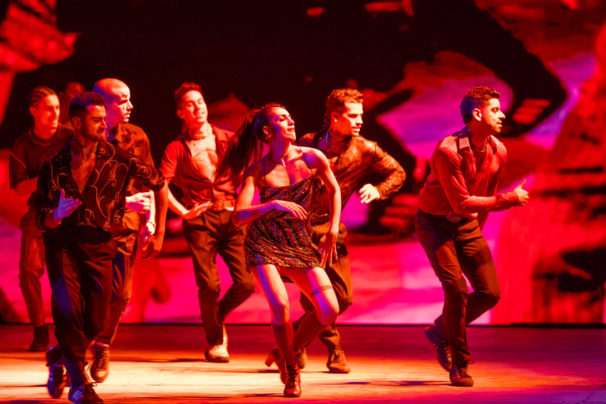
Yes, there is choreography. And no, it has nothing to do with Jerome Robbins. And yes, it often loses the competition with the giant video images. Van Hove invited fellow Belgian Anne Teresa de Keersmaeker to collaborate. Her reputation for rigorous, formalistic work (lately often to Bach) precedes her, but her ability to generate movement that delineates characters or pitches the action forward, is limited. By the time the Mambo takes place, we’ve already seen a certain sink-to-the ground, flip-over, lie-prone sequence three times. The way the dancers employ their arms often looks disconnected rather than organic. Keersmaeker’s contribution is strongest in “America,” which has energy and tension and allows each performer’s individuality shine through.
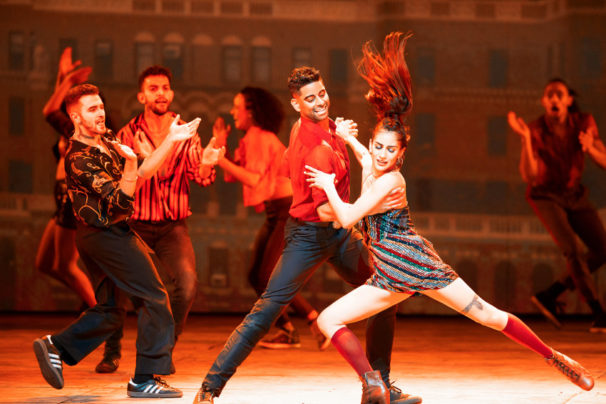
The general lack of strong group identity for the rival gangs is partly due to their not being provided with truly distinctive movement. West Side Story‘s drama, humor and tragedy have always come across as much through movement as through words or scenes. This time around, we get blocks of dancing that don’t feel integral to the larger scenario. We also get some forced overhead video shots of ensemble sequences that seem designed to impress but only end up being distracting. Turn off those cameras, Ivo, please!
West Side Story | Broadway Theatre, New York City | on now
Susan Reiter covers dance for TDF Stages and contributes regularly to the Los Angeles Times, Playbill, Dance Australia and other publications.
